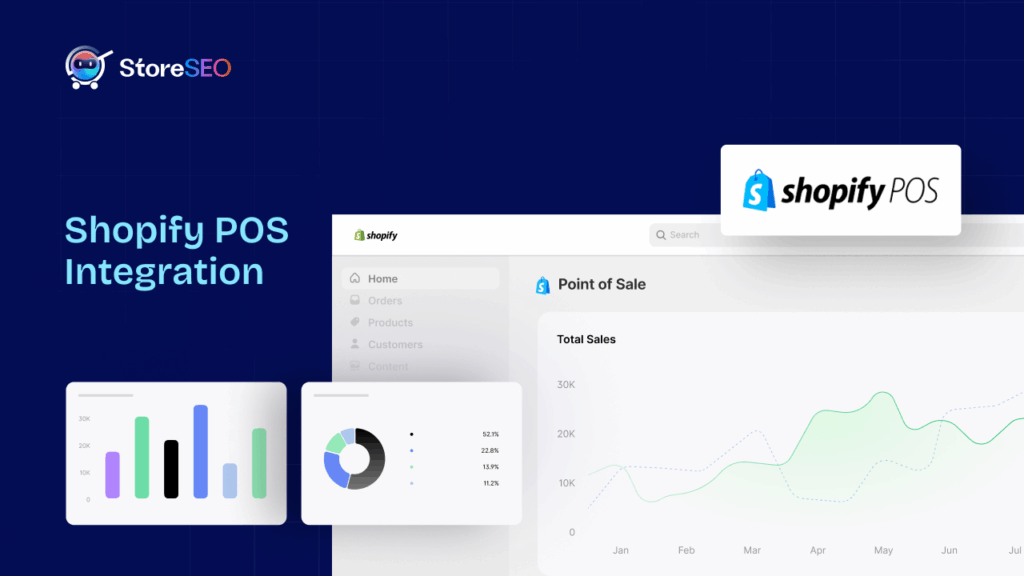In dit snelle digitale tijdperk is het belangrijker dan ooit om de polsslag van uw online bedrijf te meten. Als eigenaar van een Shopify-winkel moet u het belang van datagestuurde besluitvorming begrijpen. Daarom zijn we hier om de geheimen van Shopify-analyse en ontdek de belangrijkste statistieken die de prestaties van uw winkel in 2025 en daarna radicaal zullen veranderen.

Maak je klaar om de kracht van data te ontgrendelen en ontdek hoe deze Shopify Analytics-statistieken je verkoop kunnen laten stijgen, je merk kunnen versterken en je online winkel kunnen transformeren tot een bloeiend imperium. Ben je klaar om de sprong te wagen? Laten we erin duiken om het ware potentieel van je winkel te ontketenen!
Shopify Analytics: waarom zou u het gebruiken voor uw online winkel?
Shopify Analytics – een gebouwd datadashboard dat Shopify aanbiedt aan de E-commerce winkeleigenarenMet deze alles-in-één tool kunnen Shopify-winkeleigenaren: belangrijke analyses verkrijgen om inzicht te krijgen in de prestaties van hun bedrijf, waar verbeteringen nodig zijn en welke kansen eigenaren direct kunnen benutten.

Shopify Analytics biedt winkeleigenaren een heleboel dingen. Zoals recente activiteit, inzichten van de bezoekers, winkelsnelheid, transactierapport, en nog veel meer. Het beste is dat u als winkeleigenaar niet naar een platform hoeft te gaan of tools hoeft te gebruiken om deze belangrijke rapporten te krijgen. Shopify Analytics heeft u volledig gedekt.
Door de belangrijkste statistieken van uw Shopify-winkel te vergelijken met KPI's en benchmarks, kunt u echter slimmere zakelijke keuzes maken voor uw online winkel. Deze aanpak helpt u –
✅ Maximaliseer de impact van uw marketing- en reclame-investeringen
✅ Breng uw merk onder de aandacht op de meest effectieve verkoop- en marketingkanalen
✅ Kies de optimale producten voor zowel online als offline verkoop
✅ Krijg waardevolle inzichten in de verwachtingen van de consument
✅ Beheer de voorraad om efficiënt aan de vraag van de klant te voldoen
✅ Plan voor hogere winstmarges op basis van datagestuurde strategieën
✅ Behoud financiële stabiliteit en verbeter belastingbeheer
10+ statistieken van Shopify Analytics die u voor uw winkel moet bijhouden
Shopify Analytics biedt inzichtelijke gegevens die uw e-commercebedrijf kunnen helpen floreren in dit competitieve tijdperk van online winkelen. Door verschillende sets gegevens te kennen en te analyseren, zoals totale verkopen, netto verkopen, conversiepercentages, restitutiepercentages en nog veel meer van Shopify Analytics, kunt u strategisch plannen en winst maken met uw bedrijf. Hier leiden we u door 10+ Shopify Analytics-statistieken die u moet volgen om de conversie en verkoopLaten we één voor één beginnen.
#1 Totale verkoop
Deze Shopify Analytics-statistiek kan u helpen: Volg de totale verkopen van uw Shopify-winkels of omzet binnen een specifiek tijdsbestek. Het biedt inzicht in piekverkoopperioden, succesvolle producten en het koopgedrag van klanten. Door deze metriek in inventarisrapporten te gebruiken, kunt u patronen analyseren, u voorbereiden op piektijden en hun focus prioriteren op de best presterende producten.

#2 Netto-omzet
Netto-omzet is de som van totale omzet, kortingen, geretourneerde goederen en toeslagen voor beschadigde artikelen. Dit belangrijke cijfer onthult de werkelijke omzet die door uw online winkel wordt gegenereerd en geeft aan of er sprake is van groei of achteruitgang.
De impact van deze metriek is verstrekkend en heeft invloed op verschillende aspecten, zoals productprijzen en voorraadbeheer. Als uw Shopify-winkel het branchegemiddelde overtreft in termen van zowel bruto- als netto-omzet, kan dit betekenen dat ze grotere kortingen bieden of een hoger volume aan retouren ervaren in vergelijking met hun concurrenten in de branche.
#3 Gemiddelde bestelwaarde (AOV)
Gemiddelde orderwaarde is een van de prominente statistieken van Shopify Analytics. Het monitoren van deze statistiek is van het grootste belang in elk Shopify-rapport. Het geeft u een duidelijk inzicht in de maximale winstgevende uitgaven die je kunt gebruiken om klanten te werven.

#4 Online conversiepercentages
Om ervoor te zorgen dat uw websites effectief zijn ontworpen om aankopen van bezoekers te stimuleren, is het cruciaal om deze metriek te monitoren. Gemiddeld behalen online winkels een conversieratio van ongeveer 3%. Echter, een onderzoek uitgevoerd in januari 2022 door Littledata onder 3768 Shopify-winkels bleek dat het gemiddelde conversiepercentage 1,9% was.
Vergeet niet dat de conversieratio meer omvat dan alleen verkopen. Het omvat ook het inzetten van Calls To Action (CTA's) om uw sitebezoekers te motiveren om op advertenties te klikken, items aan hun winkelwagen toe te voegen, zich te abonneren op een mailinglijst en berichten op sociale media te delen.
#5 Terugkerende klanttarief
Het terugkerende klantpercentage meet hoeveel van uw klanten meerdere aankopen hebben gedaan in uw winkel. Het laat zien hoe vaak mensen terugkomen om opnieuw bij u te kopen. Deze belangrijke metriek van Shopify Analytics onthult klantloyaliteit en de lange termijnwaarde ze brengen naar uw bedrijf. Gemiddeld genomen geven studies aan dat de terugkerende klantpercentages variëren van 20% tot 40%, wat het belang van het stimuleren van herhaalaankopen benadrukt.

#6 Restitutiepercentage
Het restitutiepercentage dient als een cruciale kwaliteitsborgingsmaatstaf, waarmee u kunt bepalen welke producten niet aan de verwachtingen van de klant voldoen. U wilt uw klanten altijd tevreden stellen, dus moet u bepalen welke producten niet aan de verwachtingen voldoen. U hebt hier twee opties: verwijder deze producten uit uw catalogus of pas de prijzen aan door de analyse van het restitutiepercentage te krijgen.
#7 Verkoop per kanaal
De metriek Verkoop per kanaal laat zien hoeveel verkopen die u via verschillende kanalen hebt gedaan, zoals uw online winkel, koopknop of app. Door deze gegevens te analyseren, kunt u gebieden identificeren die aandacht vereisen en uw marketinginspanningen richten op het stimuleren van de verkoop.
#8 Verkoop door verwijzer
De verkoopcijfers per verwijzende partij laten zien dat bronnen van uw verkopen, waardoor u waardevolle inzichten krijgt in hun oorsprong. Het is alsof u een kaart hebt die u precies laat zien waar uw verkopen vandaan komen.
Wanneer klanten bijvoorbeeld op een link klikken die op sociale media wordt gedeeld, valt dit onder de 'Sociaal' categorie. Als ze via een link in een e-mail komen, wordt dit ook gecategoriseerd als 'E-mail.' Wanneer klanten de URL van uw winkel rechtstreeks in hun browser invoeren, wordt dit als een 'Direct' verwijzing. Als ze uw winkel ontdekken via de resultatenpagina van een zoekmachine, valt deze onder de 'Zoekopdracht' categorie. Als de bron van de verwijzing ten slotte onbekend is, wordt deze gelabeld als 'Onbekend.'
Met deze metriek krijgt u inzicht in de verschillende kanalen waarlangs uw verkopen plaatsvinden. Zo kunt u weloverwogen beslissingen nemen om uw marketingstrategieën te optimaliseren en uw succes verder te vergroten.
#9 Producten op type
Producten per type is een ander belangrijk onderdeel van Shopify Analytics. Het is cruciaal om de producttypen in Shopify Analytics nauwlettend in de gaten te houden. Met deze analyse kunt u achterhalen welke typen producten goed verkopen en welke het moeilijk hebben. Nadat u de inzichten hebt, kunt u een juiste marketingstrategie dat zou de verkoop van producten met een lagere verkoopsnelheid zeker een impuls kunnen geven.
#10 Meest verkochte producten
Met deze metriek kunt u de ware interesse van consumenten ontdekken en gegevens krijgen over welke producten het populairst zijn op basis van hun verkoopvolume. Het gaat verder dan omzet en bestelnummers, en geeft u een duidelijk inzicht in welke producten de favorieten van het publiek zijn. Blijf de concurrentie voor door ervoor te zorgen dat deze populaire artikelen altijd op voorraad zijn, klanten tevreden stellen en het verkooppotentieel maximaliseren.

#11 Verzending en belastingen
De verzendmetriek van Shopify Analytics houdt bij hoeveel u uitgeeft aan het leveren van producten aan uw klanten. Het omvat verzendkosten, minus verzendkortingen en terugbetaalde verzendkosten. Bovendien moet u op de hoogte blijven van de belastingkosten van uw Shopify-winkel. Deze metriek berekent het totale belastingbedrag op basis van hun bestellingen.
Gebruik Shopify Analytics en volg belangrijke e-commercestatistieken
Het omarmen van de dynamische mogelijkheden van Shopify Analytics is de sleutel tot het ontsluiten van het ware potentieel van uw e-commercebedrijf. Door te begrijpen hoe uw Shopify-winkel in realtime presteert via het Shopify Analytics-dashboard, kunt u datagestuurde beslissingen nemen die impactvolle marketinginspanningen stimuleren, wat leidt tot verhoogde conversies en verkopen.
We hopen dat u dit artikel informatief en nuttig vond. Als dat zo is, vergeet dan niet om abonneer je op onze blog voor meer.








